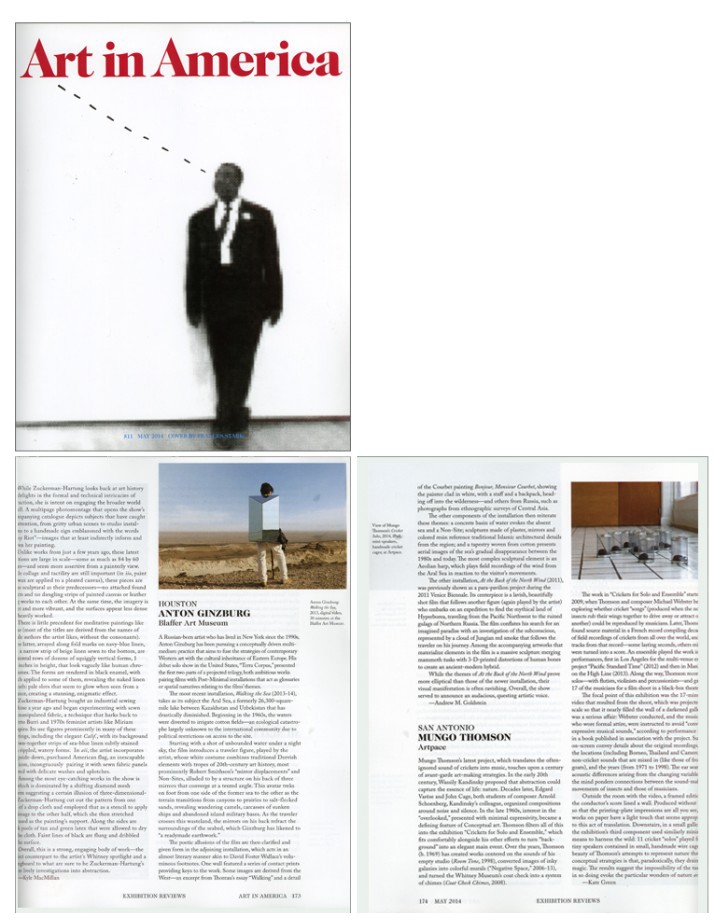A Russian-born artist who has lived in New York since the 1990s, Anton Ginzburg has been pursuing a conceptually driven multi-medium practice that aims to fuse the strategies of contemporary Western art with the cultural inheritance of Eastern Europe. His debut solo show in the United States, Terra Corpus, presented the first two parts of a projected trilogy, both ambitious works pairing films with Post-Minimal installations that act as glossaries or spatial narratives relating to the films’ themes.
The most recent installation, Walking the Sea (2013-14), takes as its subject the Aral Sea, a formerly 26,300-square-mile lake between Kazakhstan and Uzbekistan that has drastically diminished. Beginning in the 1960s, the waters were diverted to irrigate cotton fields—an ecological catastrophe largely unknown to the international community due to political restrictions on access to the site.
Starting with a shot of unbounded water under a night sky, the film introduces a traveler figure, played by the artist, whose white costume combines traditional Dervish elements with tropes of 20th-century art history, most prominently Robert Smithson’s “mirror displacements” and Non-Sites, alluded to by a structure on his back of three mirrors that converge at a tented angle. This avatar treks on foot from one side of the former sea to the other as the terrain transitions from canyons to prairies to salt-flecked sands, revealing wandering camels, carcasses of sunken ships and abandoned island military bases. As the traveler crosses this wasteland, the mirrors on his back refract the surroundings of the seabed, which Ginzburg has likened to “a readymade earthwork.”
The poetic allusions of the film are then clarified and given form in the adjoining installation, which acts in an almost literary manner akin to David Foster Wallace’s voluminous footnotes. One wall featured a series of contact prints providing keys to the work. Some images are derived from the West—an excerpt from Thoreau’s essay “Walking” and a detail of the Courbet painting Bonjour, Monsieur Courbet, showing the painter clad in white, with a staff and a backpack, heading off into the wilderness—and others from Russia, such as photographs from ethnographic surveys of Central Asia.
The other components of the installation then reiterate these themes: a concrete basin of water evokes the absent sea and a Non-Site; sculptures made of plaster, mirrors and colored resin reference traditional Islamic architectural details from the region; and a tapestry woven from cotton presents aerial images of the sea’s gradual disappearance between the 1980s and today. The most complex sculptural element is an Aeolian harp, which plays field recordings of the wind from the Aral Sea in reaction to the visitor’s movements.
The other installation, At the Back of the North Wind (2011), was previously shown as a para-pavilion project during the 2011 Venice Biennale. Its centerpiece is a lavish, beautifully shot film that follows another figure (again played by the artist) who embarks on an expedition to find the mythical land of Hyperborea, traveling from the Pacific Northwest to the ruined gulags of Northern Russia. The film conflates his search for an imagined paradise with an investigation of the subconscious, represented by a cloud of Jungian red smoke that follows the traveler on his journey. Among the accompanying artworks that materialize elements in the film is a massive sculpture merging mammoth tusks with 3-D-printed distortions of human bones to create an ancient-modern hybrid.
While the themes of At the Back of the North Wind prove more elliptical than those of the newer installation, their visual manifestation is often ravishing. Overall, the show served to announce an audacious, questing artistic voice.

